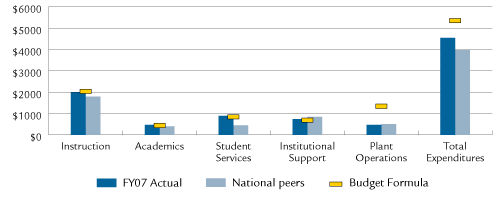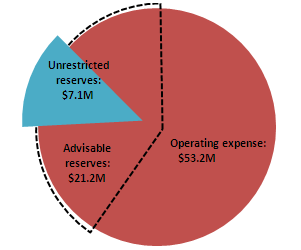Holyoke Community College
Holyoke Community College (HCC) serves the Pioneer Valley by providing comprehensive, high-quality educational opportunities that are responsive to community needs and meet the intellectual, aesthetic, and practical needs of a diverse student body and to the economic and social needs of the region. The College offers a full range of programs and services appropriate to a community college.
Program of Distinction
Collaborations
Access Indicators
Affordability Indicators
Student Success and Academic Quality Indicators
Fiscal Effectiveness and Efficiency Indicators
Program of Distinction
In spring 2008, Holyoke Community College held the first statewide “Diversity and Inclusion Summit” for Massachusetts community colleges. The purpose of the summit was to provide an opportunity for community college faculty and staff to work together toward the common goal of ≴the achievement and advancement of diversity and inclusion at Massachusetts community colleges.≵ Sponsored by HCC's Council for Community, Diversity, Equity and Inclusion, the summit was designed to share information about the many programs and initiatives established to support diversity among students and staff that attend or are employed at community colleges. Forty-six individuals from 11 institutions participated in a range of presentations and round table discussions on topics such as Affirmative Action Committees/Diversity Councils, Veterans Returning from War, Dialogues on Race, Retaining Men of Color, Multicultural Academic Services, TransCampus, Free Speech and Civil Discourse, and Safe Zone and Disabilities Awareness Training. This year, HCC will host the second annual Diversity Summit in conjunction with the Community College Student Leadership Association's annual spring conference so that student leaders from the 15 community colleges will be able to learn about best practices related to issues of diversity, equity and inclusion on our campuses.
Collaborations
- The Early College High School (ECHS) program is an innovative dual enrollment program established and operated by the Springfield Public School system to help high school juniors and seniors complete their graduation requirements while taking college courses for credit. Located at HCC, the program served 81 students during FY2008 (28 juniors and 53 seniors) with a staff that included a vice principal, five teachers, two guidance counselors and one administrative assistant. Of these students, 39% were Hispanic and 38% were African-American. Eleven students took college courses in Fall 2007 with an average grade of B, while 14 students took college courses in Spring 2008 with an average grade of B. A total of 31 seniors graduated; 20 graduates (or 65%) were accepted and intended to enroll in college; four students entered the military. Eighty-five percent of the graduates planned to attend HCC. ECHS graduates received over $20,000 in scholarships. The program is funded by the Springfield Public School system with additional assistance from the Commonwealth Corporation. HCC provides space, student support services, Plato training and technical assistance.
- The ABE College Transition to College is a collaborative program between HCC and the Community Education Project, and has been in effect since 2002. The program, funded by the Nellie Mae Educational Foundation, provides free college preparation classes for individuals 18 years and older who have a GED or graduated from high school five or more years ago. Classes include extensive mentoring and tutoring, as well as instruction in math, reading, writing and computer skills. Participants receive assistance with financial aid and admissions applications, as well as access to HCC resources. From 2003 through Spring 2008, the program served 256 students with a completion rate of 84%. Of those program completers, 68% enrolled at HCC or other colleges.
- ENLACE Holyoke brings together HCC, the City of Holyoke, the Holyoke Public Schools, community organizations, private foundations and other institutions of higher learning with the goal of increasing high school graduation and college enrollment rates for Latino students. ENLACE partners work to unite civic and educational leaders with parents and students, channel increased resources into Holyoke and align existing resources for greater impact and sustainability. College pathways are created, starting at the middle school level, that focus on four strategic areas: parent and family involvement; college awareness and preparation activities; professional development for teachers, guidance counselors and youth providers; and expanded partnerships for Latino education. At HCC, these efforts have helped increase Latino student enrollment from 12% in 2002 to the current 16%. During FY2008, ENLACE received funding from ten public and private funding partners.
- The Western Mass CAITE partners, consisting of HCC, Springfield Technical Community College and UMass Amherst, met throughout FY2008 to develop pathways into postsecondary degree programs in computing disciplines for women, persons with disabilities and minorities. Two pathways have been developed to date. In the first, five Holyoke High School students were recruited to participate in a four-week summer internship program to work in the college's IT department and learn about IT careers. The second initiative was the development of a one-credit introduction to the Web course for developmental students titled: ≴It's All About Me≵ to be offered Spring 2009. Twelve students who have been recruited through the college's outreach programs are enrolled to date. CAITE is one of ten NSF Broadening Participation in Computing Alliances.
Section I: Access to Public Higher Education in Massachusetts
Access Indicators
Fall 2007 Enrollment
| Headcount |
6,461 |
| FTE |
4,364 |
Fall Enrollment
Over the last three years, fall headcount enrollment has increased 3.1%.
Over the last three years, fall full-time equivalent (FTE) enrollment has increased 9.2%.
Annual 2007–2008 Enrollment
| Headcount |
8,758 |
| FTE |
4,474 |
Annual Enrollment
Over the last three years, annual headcount enrollment has increased 2.7%.
Over the last three years, annual FTE enrollment has increased 10.3%.
Looking Back: Fall and Annual Headcount Enrollment

Fall 2007 Minority Enrollment
23.8%
Minority Enrollment
Greater than the minority representation of the institution's primary draw cities and towns (21.7%) and the Pioneer Valley Region's minority representation of 16.3%.
Section II: Affordability of Massachusetts Community Colleges
Affordability Indicator
2007–2008 Tuition and Fees as a Percent of Median Family Income
4.4%
% of Median Family Income
Comparable to the Northeast regional average of 4.9%.
Looking Back: Tuition and Fees as a Percent of Median Family Income
|
FY2004 |
FY2005 |
FY2006 |
FY2007 |
FY2008 |
| Holyoke Community College Tuition and Fees |
$3,096 |
$3,098 |
$3,188 |
$3,278 |
$3,428 |
| State Median Family Income |
$67,527 |
$68,701 |
$71,655 |
$74,463 |
$78,497 |
| "X" as a Percent of State Median Family Income |
| X = Holyoke Community College Tuition and Fees |
4.6% |
4.5% |
4.4% |
4.4% |
4.4% |
| X = Massachusetts Community Colleges' Average Tuition and Fees |
4.8% |
4.9% |
4.9% |
4.7% |
4.7% |
| X = Northeast Average Tuition and Fees |
|
4.8% |
4.8% |
4.9% |
4.9% |
Section III: Student Success and Academic Quality
Success and Quality Indicators
Fall 2006 Cohort First-Year Persistence Rate
| Retained at original institution |
59.4% |
| Retained at any institution |
65.3% |
Fall Cohort First-Year Persistence
Persistence at original institution has remained relatively stable over the last three years and is above the segmental average of 56.5%.
Looking Back: Fall-to-Fall First-Year Persistence Rate

Fall 2003 Cohort Four-Year Overall Success Rate
75.8%
Fall 2003 Cohort Four-Year Individual Success Rates
| Earned Degree/Certificate |
41.4% |
| Transferred |
16.5% |
| Earned 30 Credits |
16.4% |
| Still Enrolled |
1.5% |
| Note: Each subsequent category excludes any student included in previous category(ies) |
Fall Cohort Four-Year Overall Success Rate
This new indicator measures students who have earned a degree/certificate, transferred to another institution, earned 30 or more credits, or are still enrolled after four years. Future reports will include these outcomes over four, five, and six years for this and successive cohorts. Please see the Technical Guide for further details regarding this indicator.
2007–2008 Fall-to-Spring Retention Rate
93.0%
Fall-to-Spring Retention Rate
Fall-to-spring retention has remained relatively stable over the last three years.
FY2008 Credit Course Completion Rate
77.3%
Course Completion
Above the Board of Higher Education's target rate of 75%.
Total Degrees Conferred in FY2008
961
Degrees Conferred
Average degrees conferred per year over the last three years: 914
Looking Back: Degrees Conferred

2007 Pass Rate on the National Nursing Licensure Examination
88.9%
Nursing Exam Pass Rate
Above the Board of Higher Education's target pass rate of 85%.
FY2008 Annual Enrollment in Workforce Development Courses
7,082
Workforce Development
Average annual enrollment in workforce development courses per year over the last three years: 6,454
Section IV: Effective and Efficient Use of Resources
Effectiveness and Efficiency Indicators
Effective Projects and Initiatives
- In collaboration with the Springfield and Holyoke Public School Systems successfully applied to the Bill and Melinda Gates Foundation for $350,000 in grant funding to implement the Gateway to College program.
- In a joint effort with City of Holyoke, the Holyoke Juntos Collaborative, the Pioneer Valley Transit Authority and the Federal Transportation Administration developed a proposal and received $1.3 million for an Adult Learning Center at the Holyoke Multimodal Transportation Center.
- Cooperated with the other 14 community colleges in development of advanced emergency management information resources under the “Be Safe” first responder program.
Resource Allocation
Expenditures per Student—Actual, National Peers, and Budget Formula

Note: This graphic was revised on May 6, 2009. The previously posted graphic displayed the data inaccurately.
FY2008 Primary Reserve Ratio
| Unrestricted Reserves (UR) |
$7,113,188 |
| Total Operating Expenses (TOE) |
$53,204,838 |
| Primary Reserve Ratio (UR/TOE) |
13.4% |
Primary Reserve Ratio

Compliance
No materials weaknesses based on annual external independent audit:

